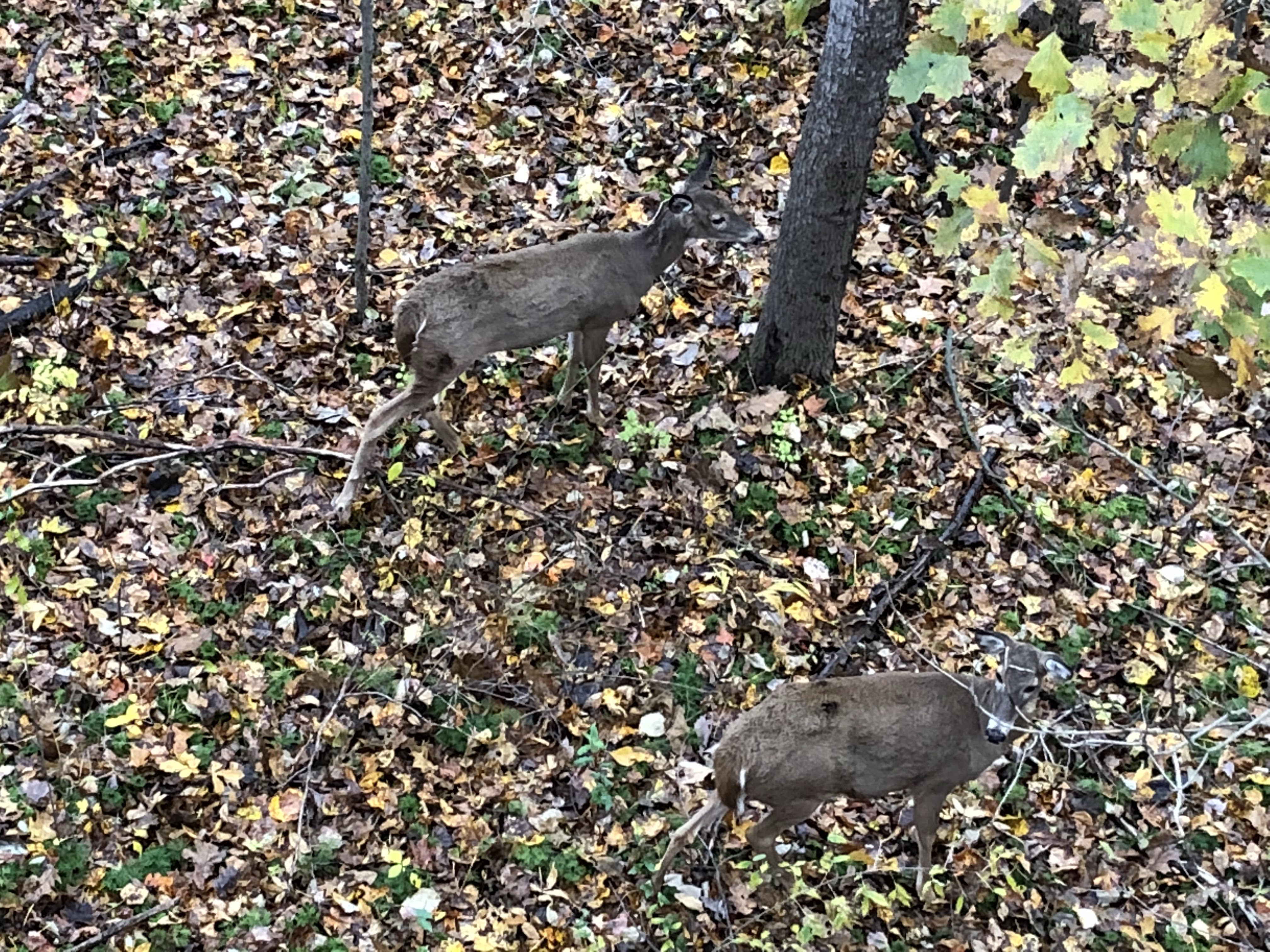Patoka Sportsman 11-10-18
Patoka Sportsman 11-10 & 11-11-18
The DCSC will have their next regular meeting on Nov. 12 at the Gaslight in Huntingburg. Special guest speaker will be Dr. Dr. Joe Caudell. He joined the Indiana Department of Natural Resources in 2016. He is assigned to the Indiana DNR Division of Fish & Wildlife. Dr. Caudell earned his doctorate in Wildlife Biology from Utah State University in 2001. He has a master’s degree from Utah State University in Wildlife Biology and a bachelor’s degree in Wildlife Management from the University of Georgia. Dr. Caudell works out of the Bloomington Field Office and should be able to be reached at (812) 334-1137 or email him directly at [email protected]. This meeting is for DCSC members only.
While field dressing your deer, look for white or red- blister-like sores (lesions) on internal organs or inside of the carcass. In the unlikely event you see lesions, exercise caution in handling the animal. Do not proceed with further processing until the carcass is examined by a State Board of Animal Health veterinarian. Refrigerate (or ice down) the carcass if possible. Keep the animal, including the head, intact until examined. To contact a veterinarian, call 1-877-747-3038 (toll free). This number is answered Monday-Friday, 8 a.m. to 4 p.m.. Messages left on weekends or holidays will be returned as soon as possible. A veterinarian will advise you, free-of-charge, about the appropriate use of the animal and may collect tissue samples for further testing.
By reporting any suspicious lesion, you are helping to protect the health status of Indiana’s white-tailed deer resource. If you submit your deer for further testing, the DNR will replace your permanent/temporary deer tag to allow revalidation of your existing license. After field dressing or handling any carcass or other raw meat, wash your hands with soap and water. Hand washing removes disease-causing bacteria, including tuberculosis. This practice should always be followed, even if the animal appears healthy. For more information on Indiana's deer TB monitoring program, contact the Board of Animal Health at (317) 544-2400.
Wildlife Manager, Kalli Dunn, is seeking help from the hunting public to help with Chronic Wasting Disease (CWD) surveillance. Kalli will require collecting lymph nodes from the neck of the deer. If you are willing to let Kalli sample your deer, during any of the deer seasons, please contact her within 24 hours of the kill. Chronic Wasting Disease is more likely evident in older deer. Therefore, she only wants deer that are 1.5 years and older. Keep deer cool (but not frozen) or remove head below “Adam’s apple”. Kalli will come to you to collect the sample or arrangements can be made to meet at the Glendale F & W Area office. If you plan to head or shoulder mount your deer it is not a candidate for this collection due to the damage caused to the neck. Kalli’s contact information: [email protected] Office (7am – 2pm): 812-644-7711
Select Indiana state parks will close for four days in the coming weeks to allow for controlled deer reductions. The dates for the temporary closings are Nov. 12-13, and Nov. 26-27. Local parks that this affects are Brown County State Park, Harmonie State Park and Lincoln State park.
Hunters can check in their game online through the CheckIN Game system, in the Fish & Wildlife Online Services application, at an on-site check station, or by phone. The online CheckIN Game system and the Fish & Wildlife Online Services can be used with any Internet-connected device. Both of these options are free, and you don’t need to set up an account online to check in your game. You can purchases licenses, check in game, view your check-in history, get your HIP number, purchase a gift certificate or make a donation through your account. The phone-in option (1-800-419-1326) carries a $3 fee (Visa or Mastercard only). Even at on-site check stations, station managers will enter information online through the CheckIN Game System. Stations no longer use paper log books or issue metal tags.
Call TIP if you see, hear or learn about poaching or another fish-and-wildlife rule violation. If your “TIP” leads to an arrest, you may receive as much as a $200 reward, and you can remain anonymous. Call 1-800-TIP-IDNR, 24 hours a day, 7 days a week.
The annual Hunters for the Hungry program administered by the Dubois County Sportsmen’s Club is going on now through the end of deer season January 6. Any hunter who harvests a deer can donate it to the Hunters for the Hungry by taking it to Sanders Processing in Celestine, Ferdinand Processing, Cannelburg Processing or Ohio Valley Custom Deer Processing in English. Processing will be paid for through a grant from the Sportsmen’s Benevolence Fund acquired by the Dubois County Sportsmen’s Club. All donated deer meat is packaged and distributed through area food banks. Each donated deer will give the hunter an entry to win a gun donated by Dr. Greg Gordon and Jasper Optical Lab.
Last week I mentioned that one of our processors had to turn away two deer because the meat had spoiled. The weather is still warmer than normal and it does create a problem when harvesting a deer especially at night and if you can’t find it right away.
The ideal temperature for bacterial growth is between 70 and 120 degrees. Under ideal conditions, bacteria can double about every 20 minutes. Therefore, the whole time the dead deer’s meat is above 70 degrees, microorganisms are multiplying rapidly, a condition that only diminishes a bit from 70 down to 40 degrees. After meat temperature falls to 40, bacteria reproduction drops drastically. Meat (not air) temperatures between 30 and 40 are the perfect temperature for fresh meat refrigeration.
Any time the environmental temperature is 40 F or warmer, spoilage is a major concern. Keep in mind that insulators will hold the meat temperature higher, longer. For example, most of the time, a deer that is left on the ground will spoil more rapidly than a deer that is hung from a meat pole and exposed to air. The only exception would be in weather conditions wherein the ground is very cold compared to the air temperature.
So if you shoot a deer at 50 degrees, but the skies are clear and you expect the temperature to fall into the high 20s that night, your deer is safer than if the temperature is 45, it’s cloudy with an approaching warm front and the night temperatures are going to stay above 40. If the temperature is 40 F or higher, we have little choice and need to make an effort to find the deer as soon as possible.
Do you process your own deer? If so do you hang your deer to cool by the head or the other end? The ideal way to hang your meat for aging is using a technique called the tenderstretch method. The tenderstretch method is done by placing a hook beneath the pelvic hip bone or below the ligament passing along the backside. When done properly, the hindquarters of your deer will hang at a 90-degree angle. When a deer is hung by the neck or Achilles tendon, gravity pulls on the hindquarters and puts tension on the muscles as they experience rigor mortis. When a deer is hung the tenderstretch way, the hindquarters are relaxed and have limited contraction during rigor mortis.
Because of this, the aging process is drastically sped up. Some even estimate that two days of tenderstretch hanging is the equivalent of two weeks of Achilles hanging. You’re guaranteed to notice it at the dinner plate, too.
In a blind taste test, the Commonwealth Scientific and Industrial Research Organization pitted beef Achilles hung cuts against tenderstretch cuts on the grill. The panel overwhelmingly scored the tenderstretch meat better in taste, juiciness, and tenderness, especially for the rump roast, striploin, outside flat, and topside steaks. In a similar test with stir-fried cuts, the tenderstretch striploin, outside flat, and topside steaks won again.The only decrease in quality came with the tenderloin, but that’s a little slice of heaven that should be eaten before your deer ever makes it to the locker anyway.
The reason the tenderstretch method isn’t more popular is because it’s less economical for butchers. A deer hanging by the Achilles tendon takes up less room in a freezer than one that has its hindquarters protruding out from the body. If you’re doing your own processing, though, there’s no reason to run a knife through the Achilles tendons ever again.




